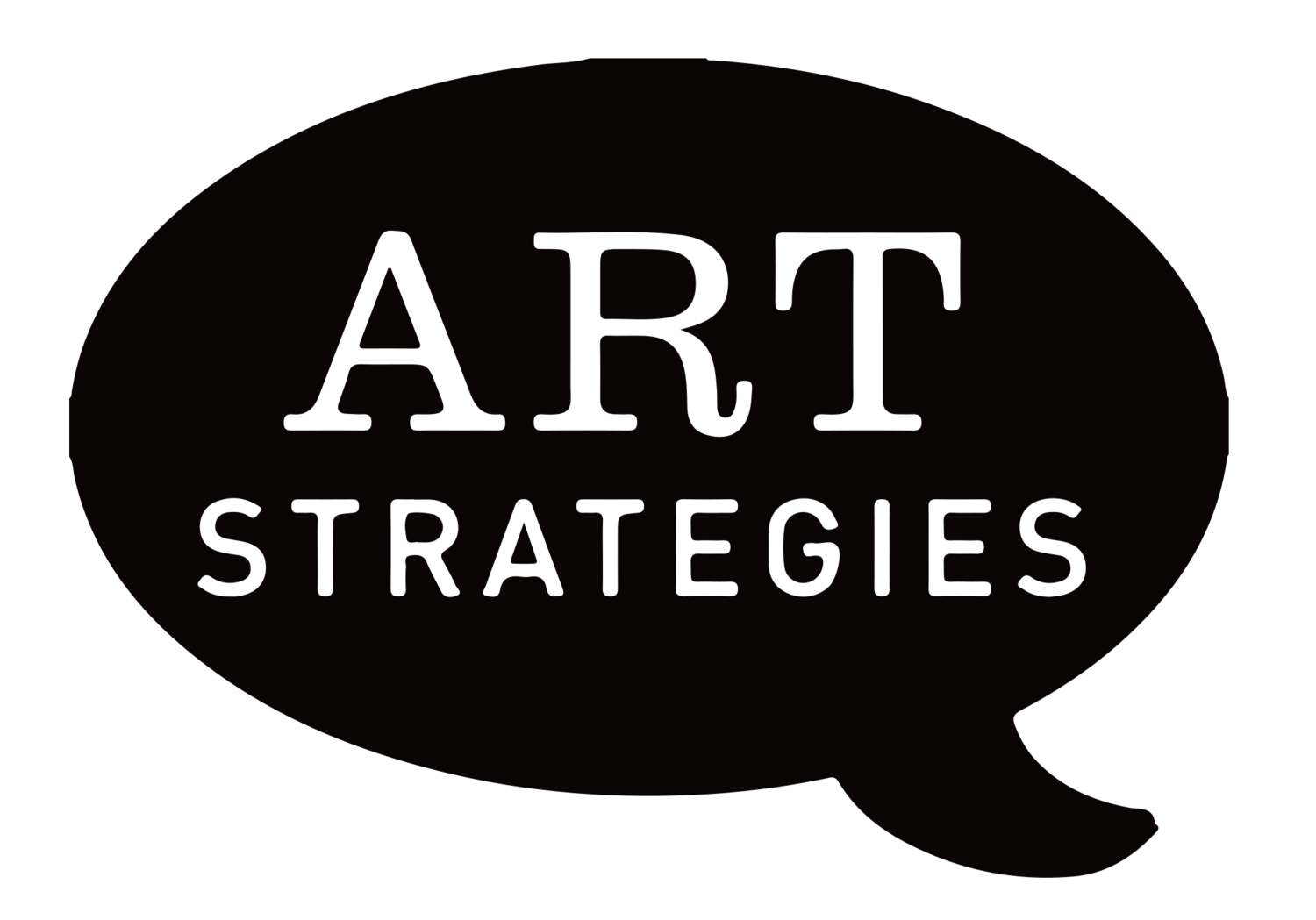



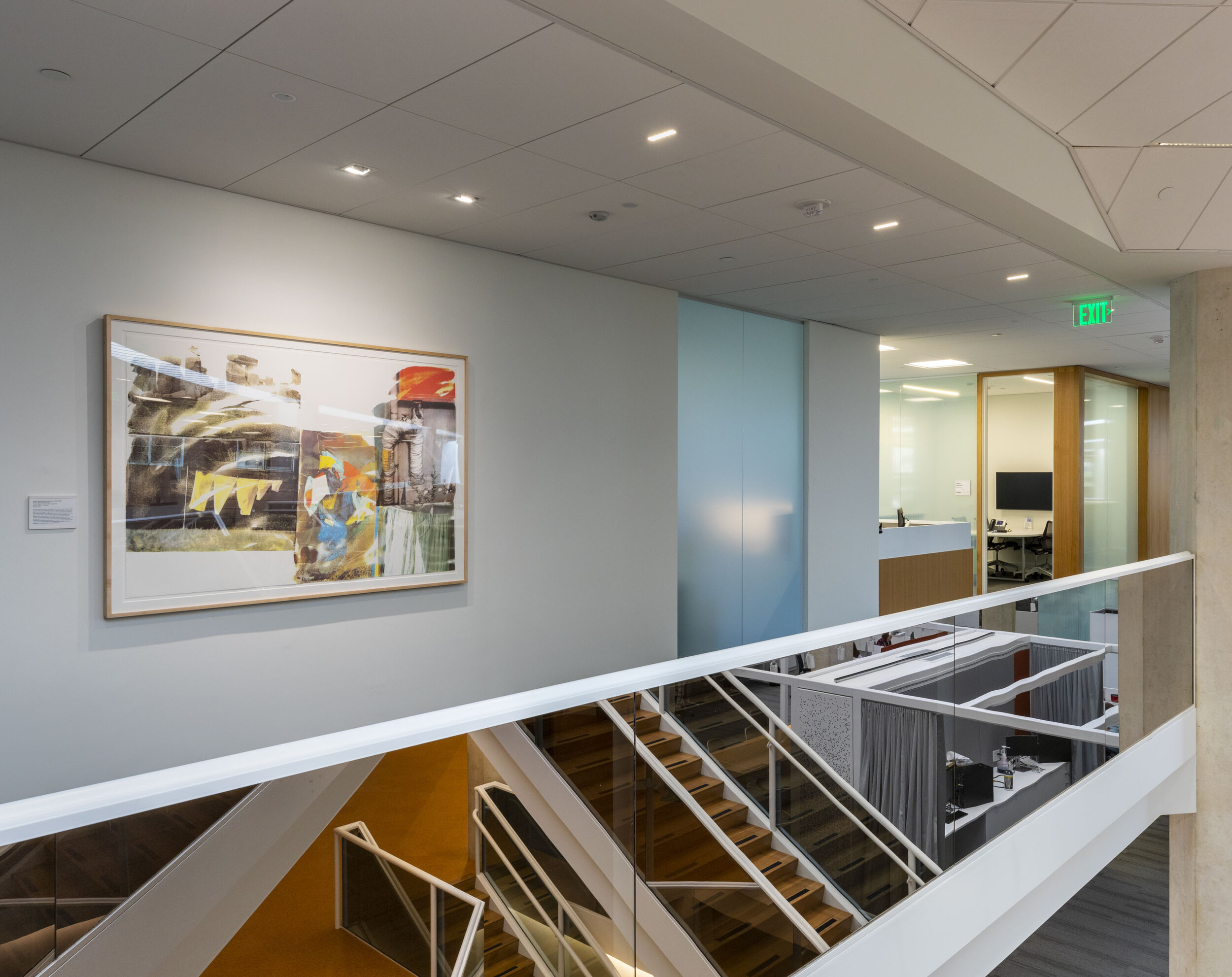

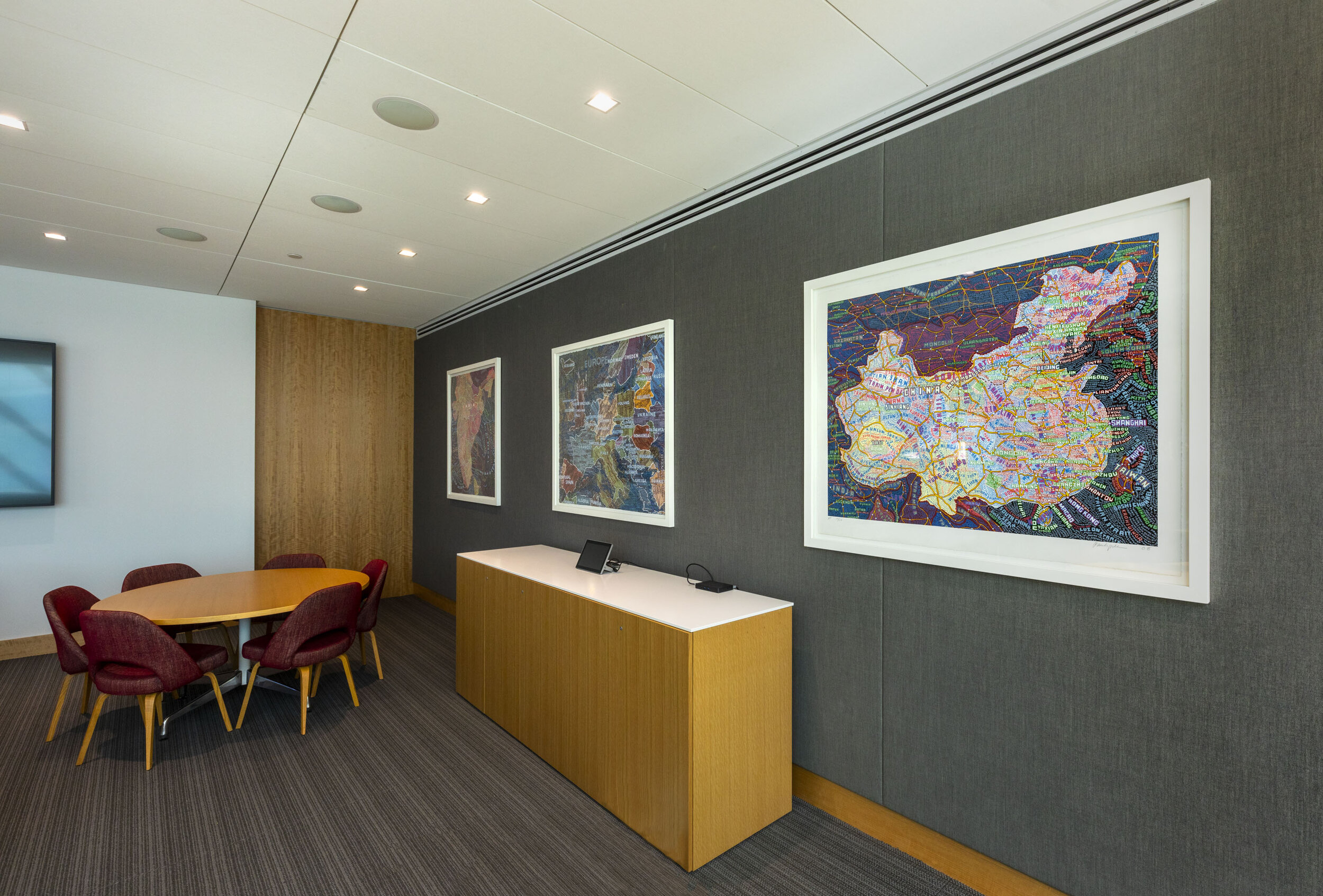
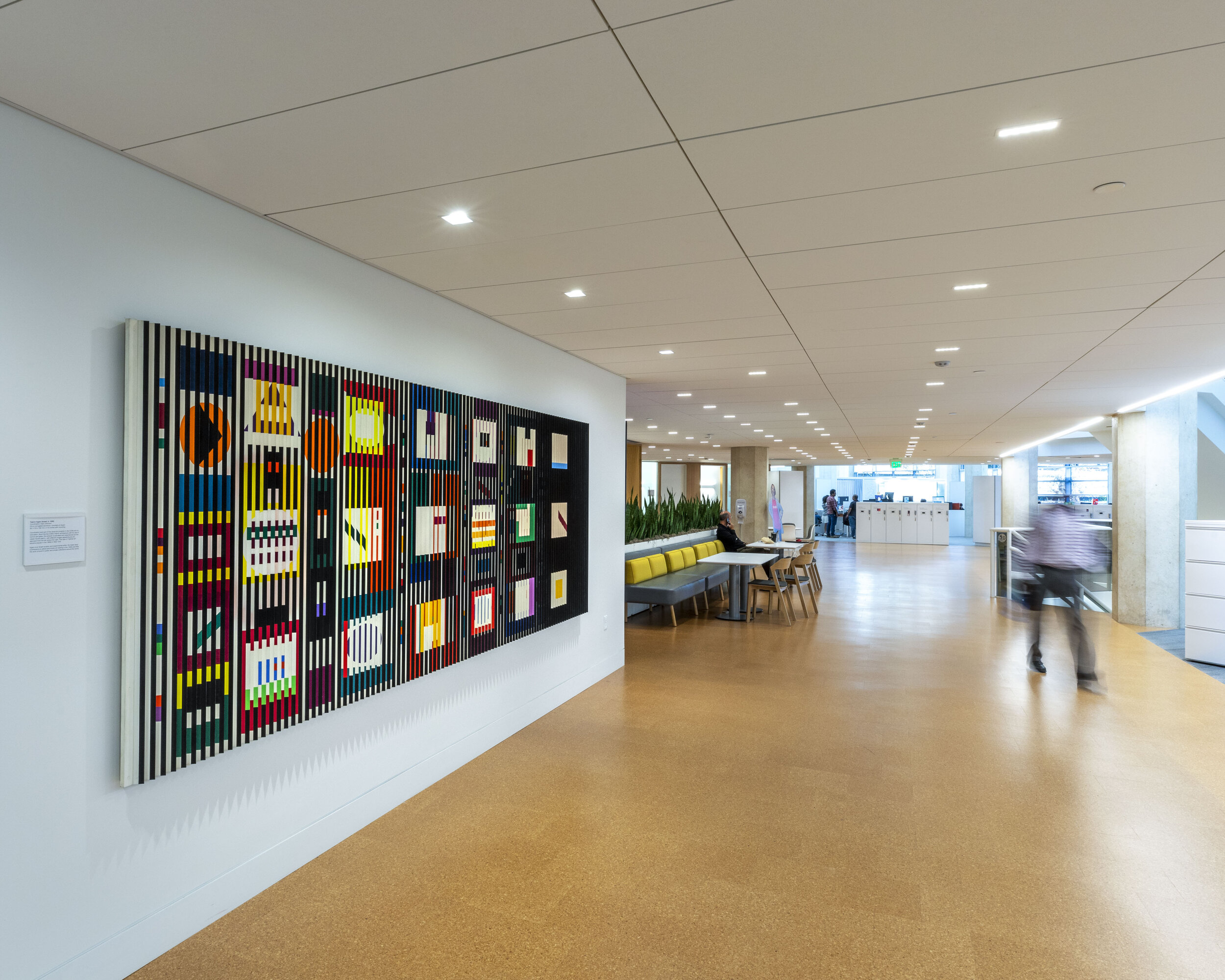
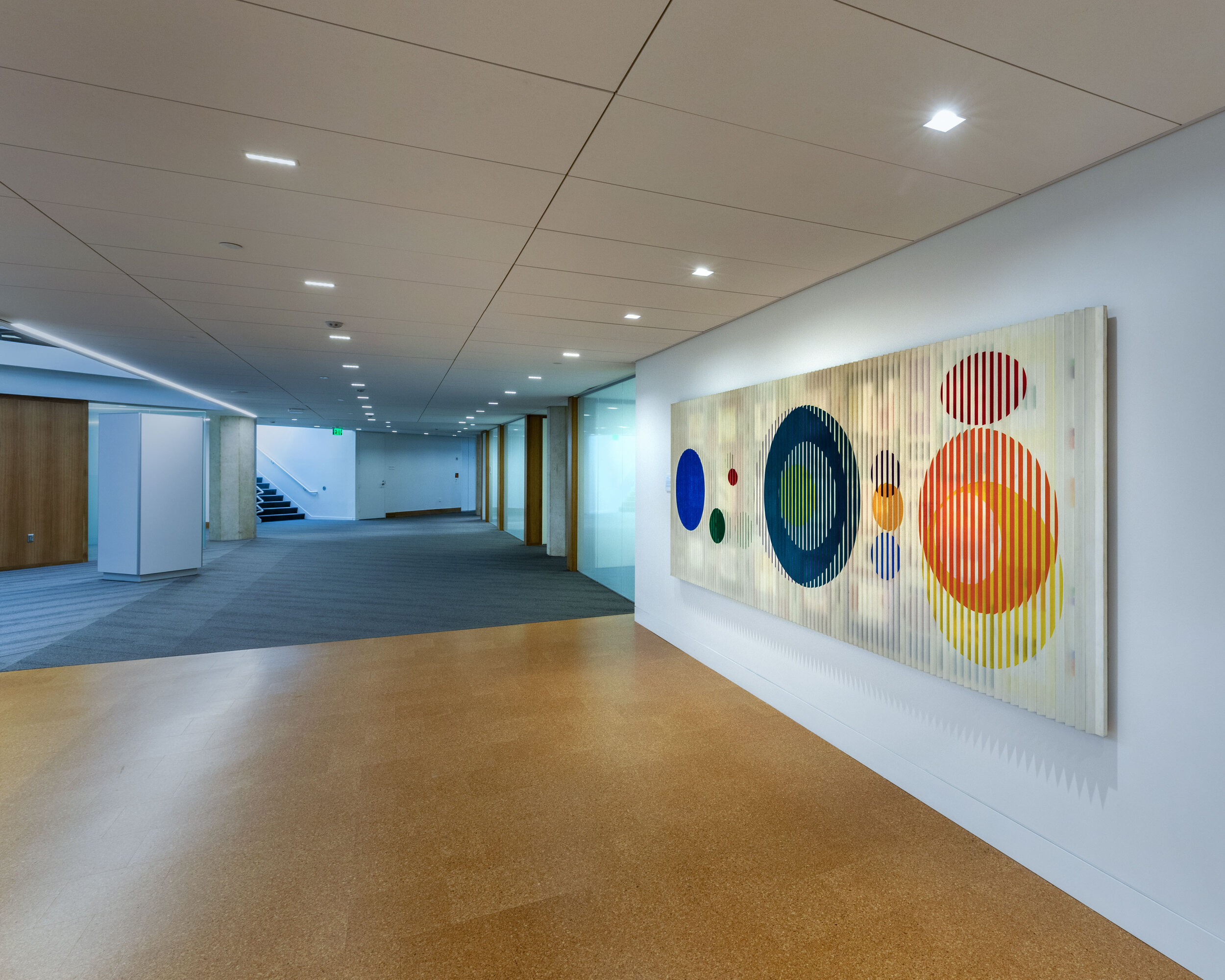
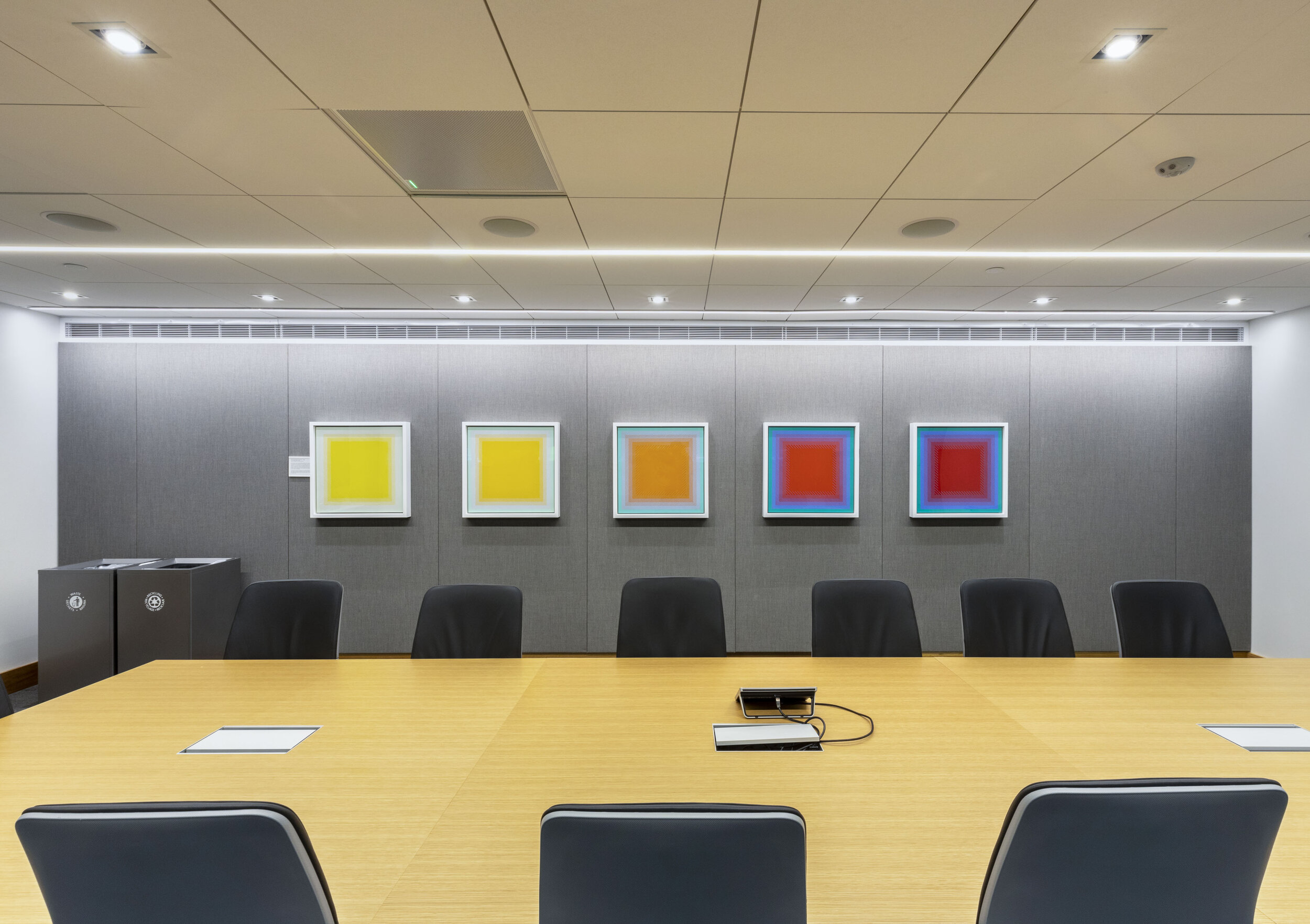
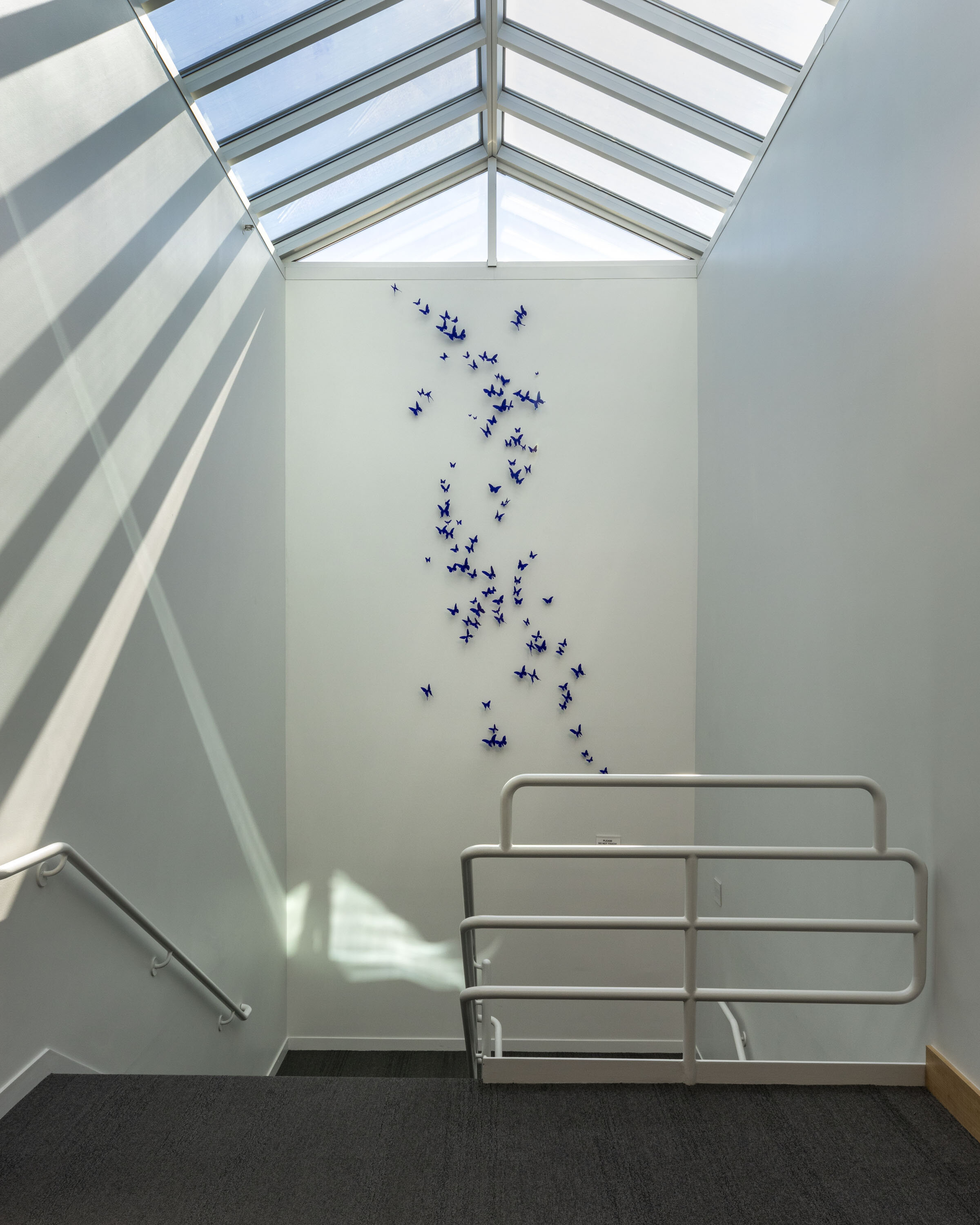
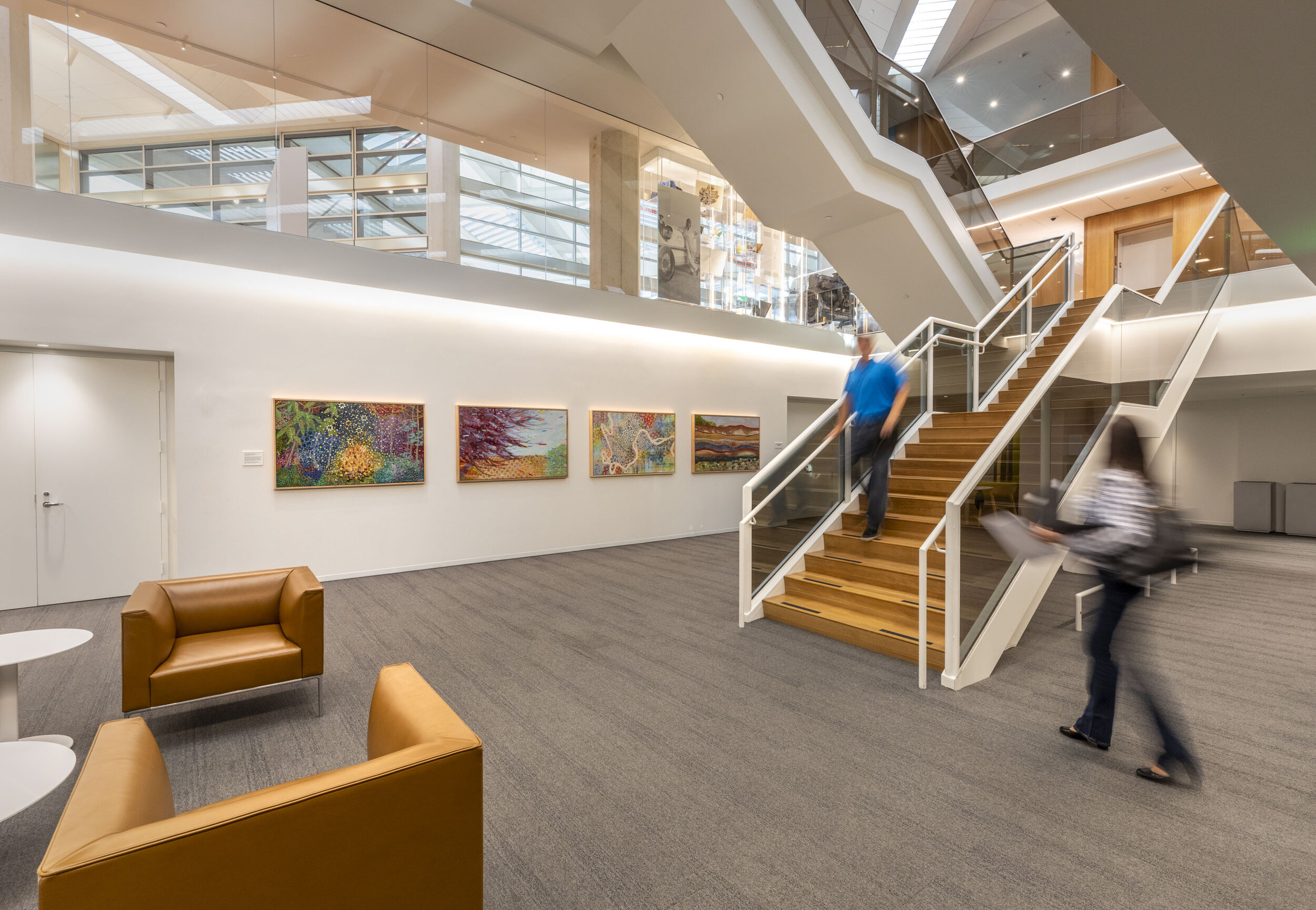
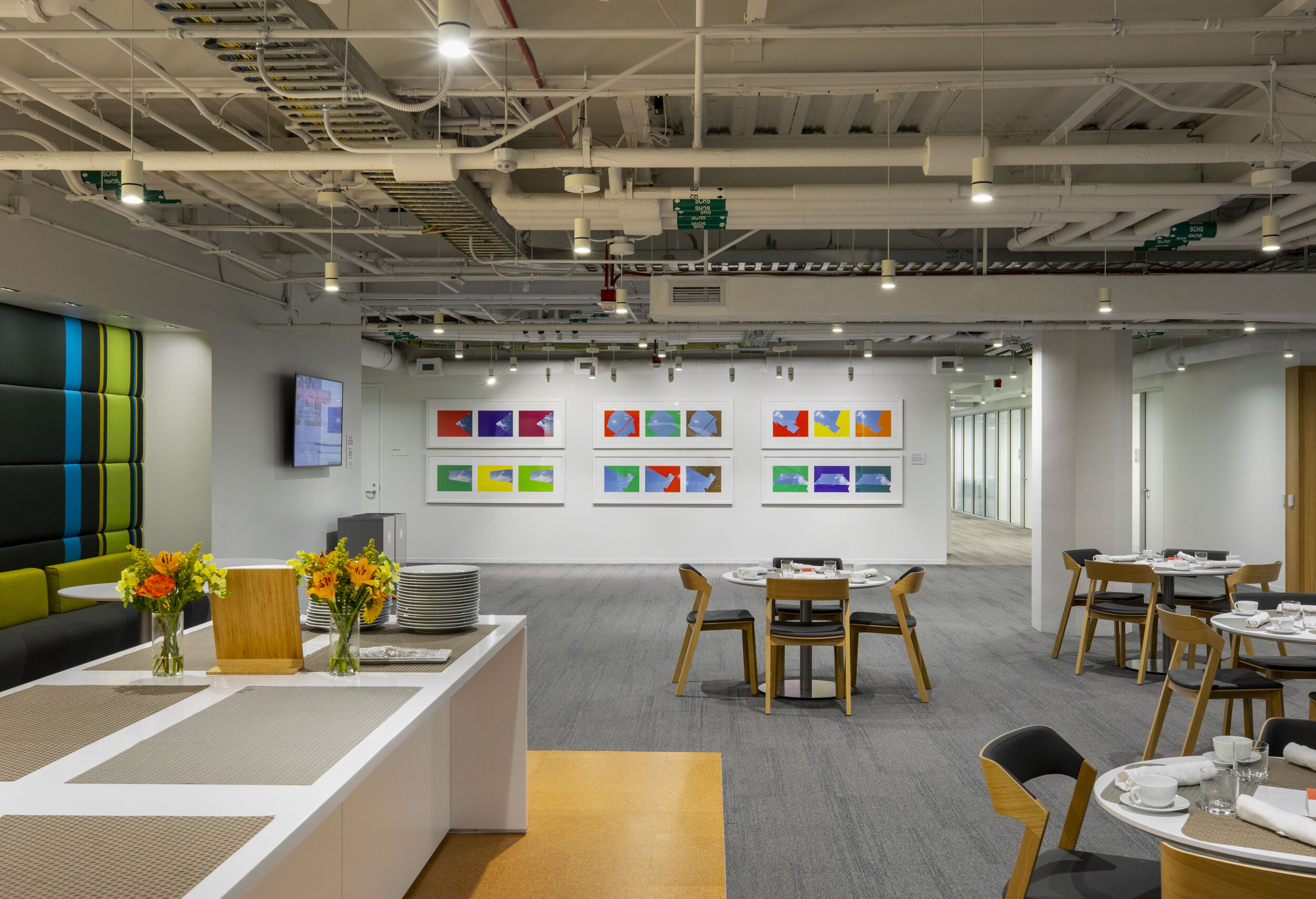
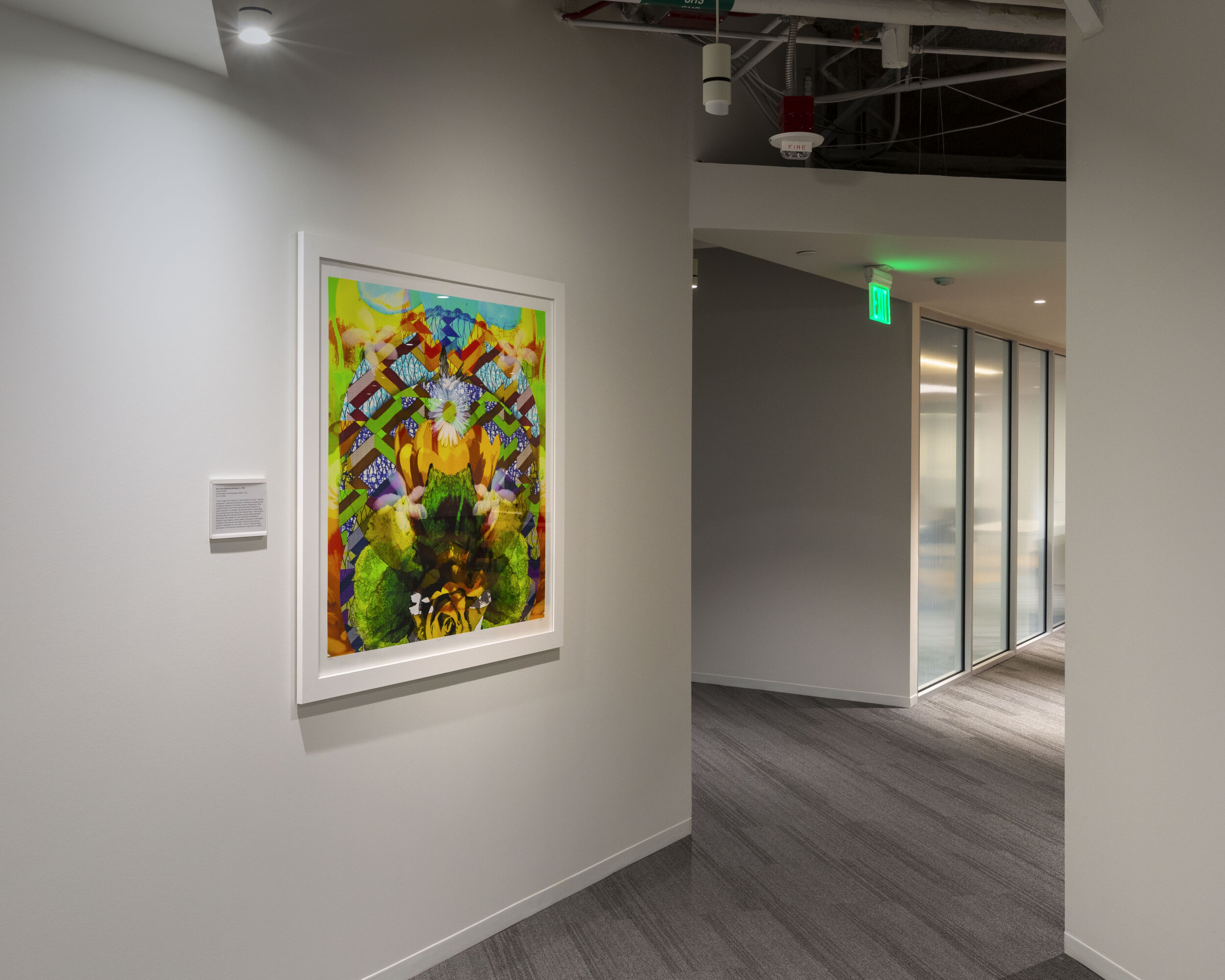
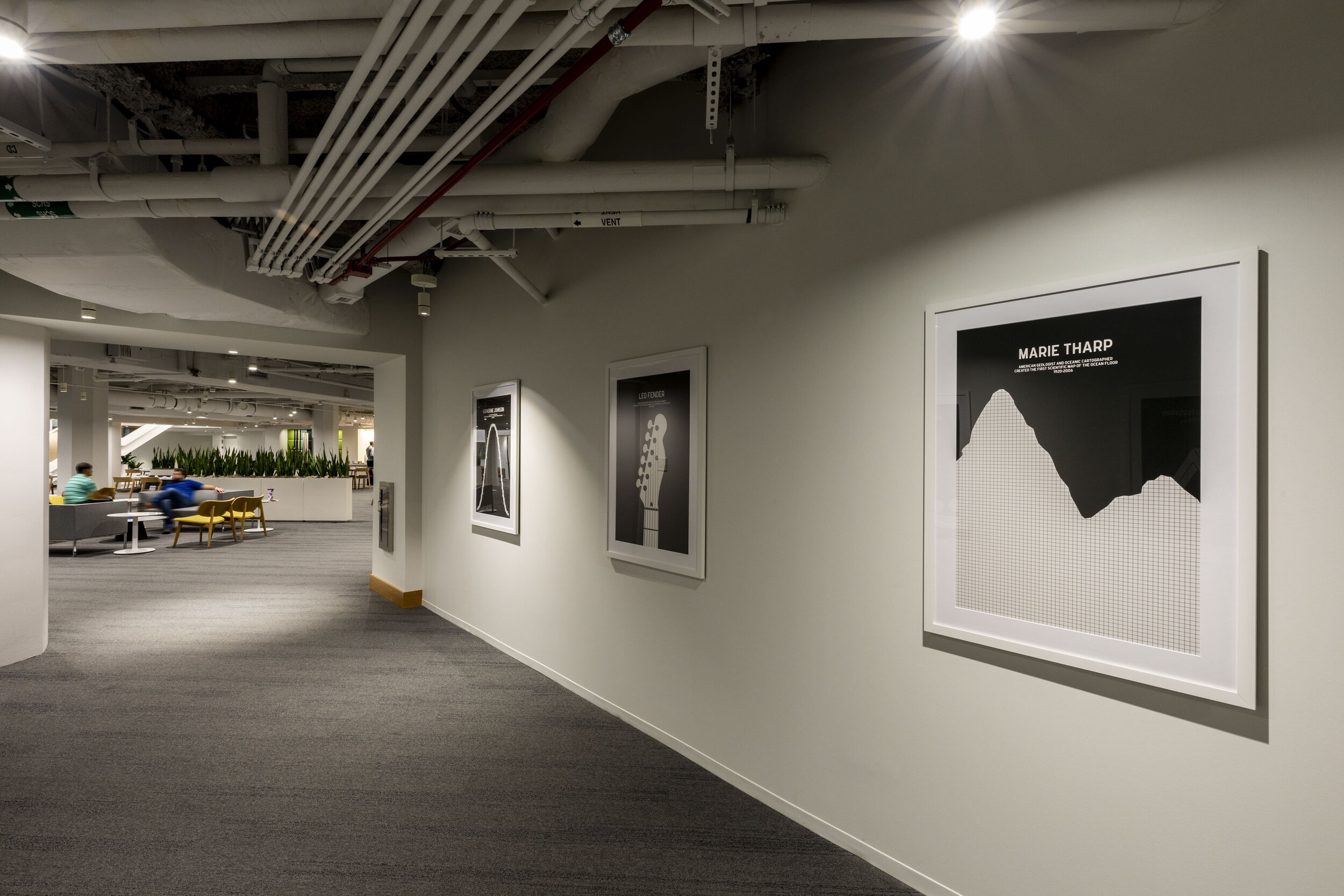
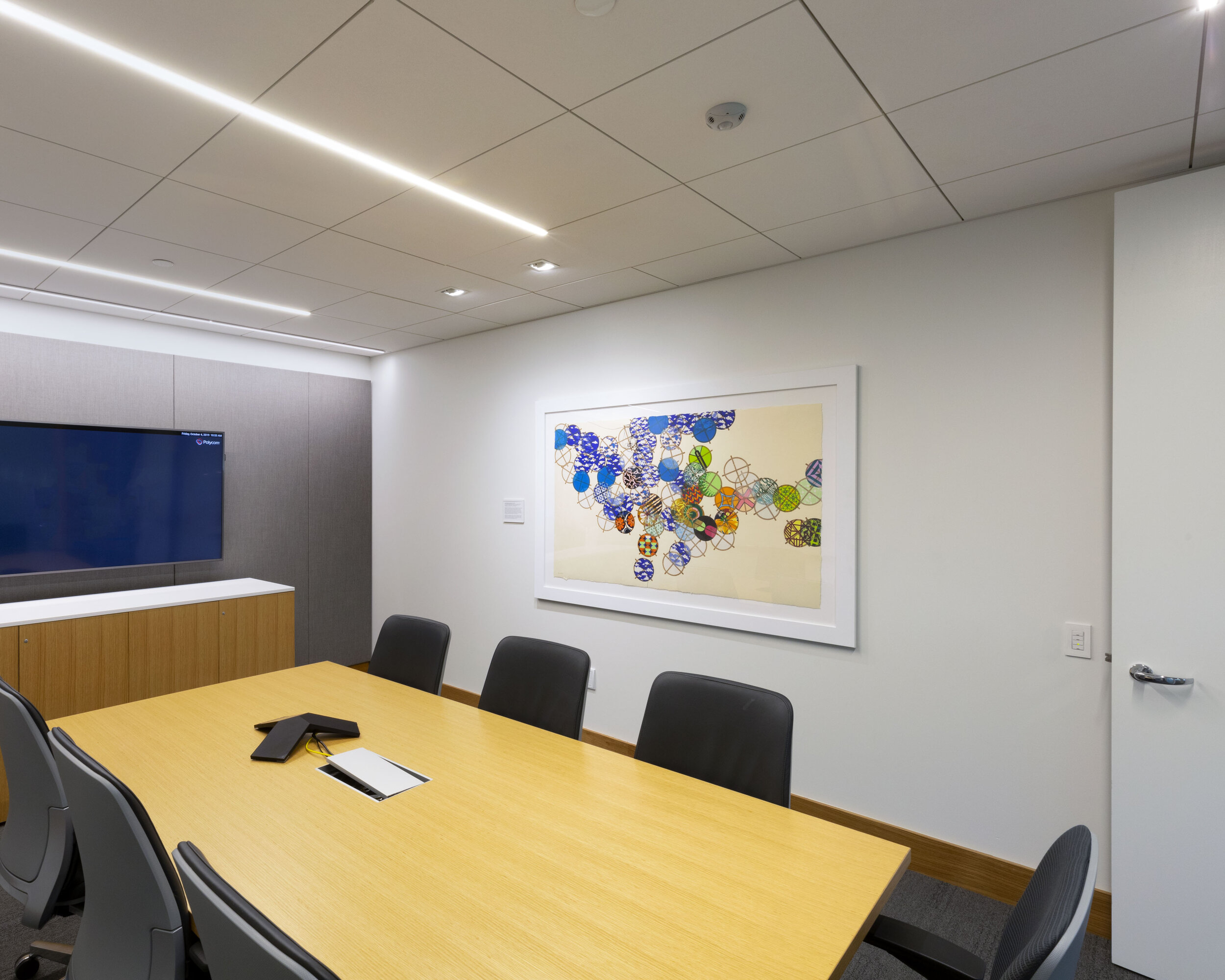
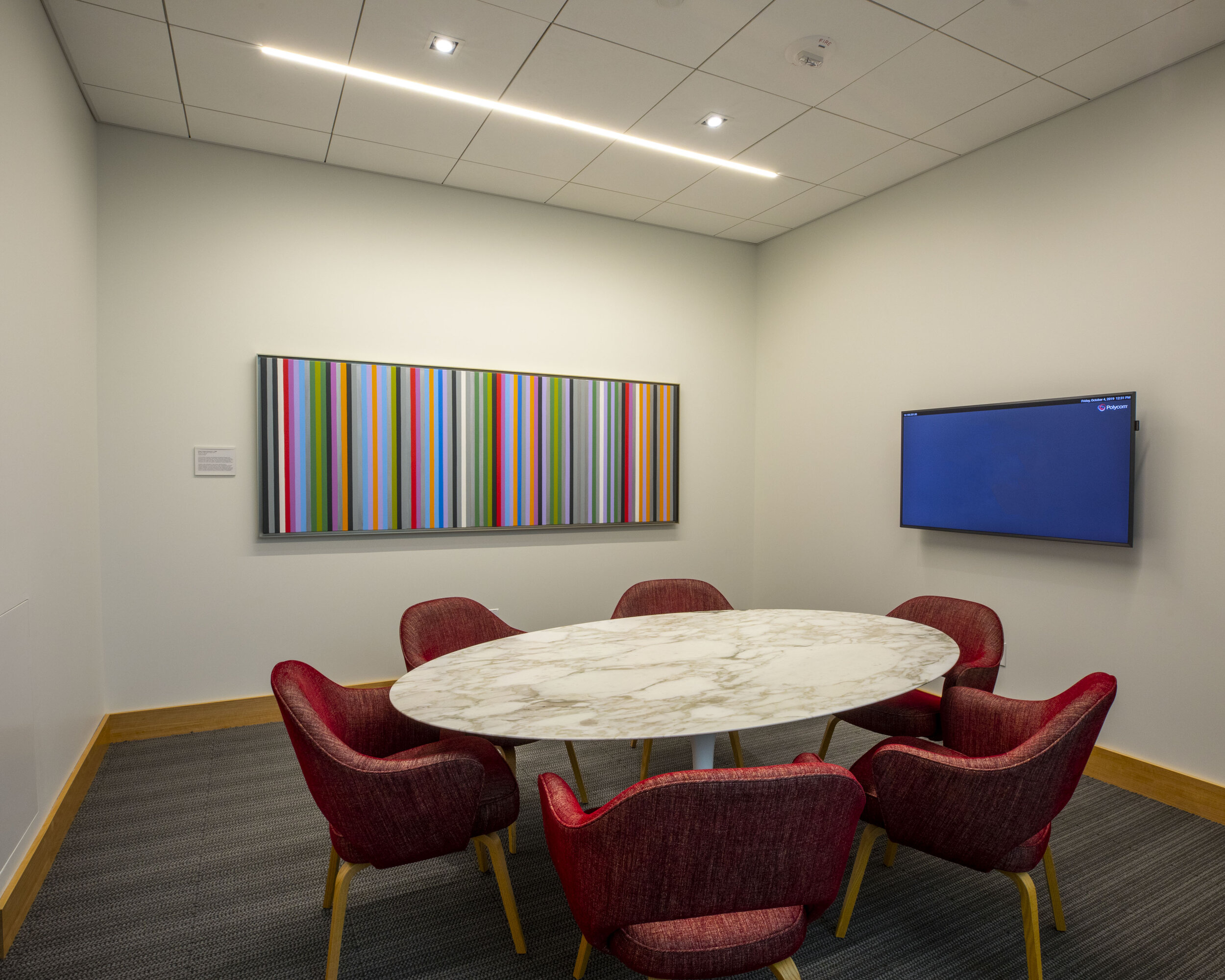
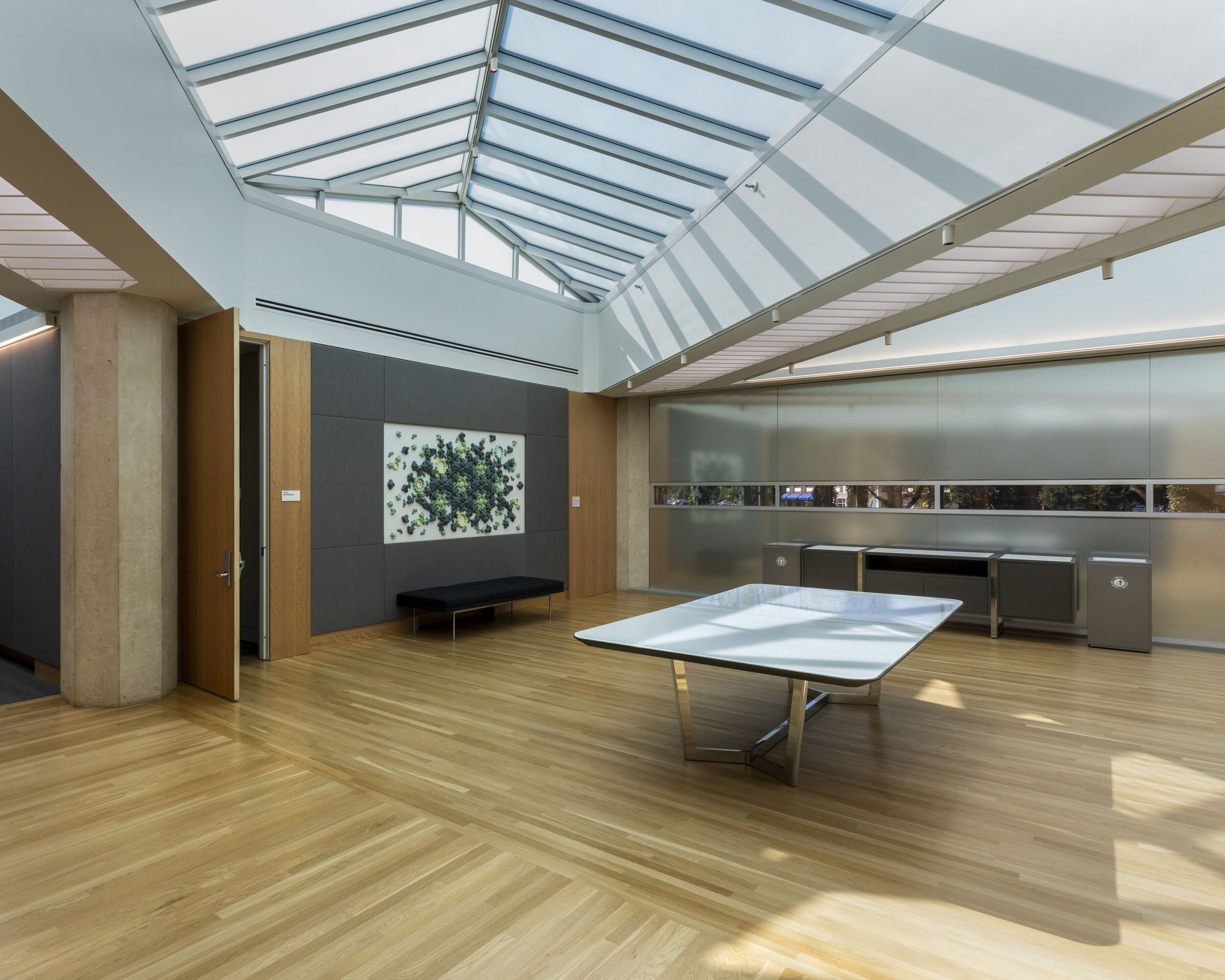

As part of the renovation of the 1980’s Kevin Roche design headquarters for Cummins Inc., Art Strategies inventoried, conserved, and redeployed historic art assets while also managing the commission of three site-specific artworks and the acquisition of another approximately 30 contemporary artworks by local as well as internationally renowned artists that connect with the company’s mission, vision, and values. The building is approximately 360,000 square feet and was renovated in two Phases.
Jason Middlebrook (American, b. 1966)
A Growing Landscape, 2016
Site-specific acrylic wall painting in two parts
53 feet ¾ inches wide x 9 feet 10 inches tall
43 feet 8 ¾ inches wide by 9 feet 10 inches tall
This painting references movement across the global landscape, evoking a spatial optimism and an open-ended journey. It was specifically commissioned for the renovated Cummins Corporate Office Building (COB) to reference Cummins’ commitment to the environment, sustainable business practices, and the global diversity of its staff and customers.

Detail:
Jason Middlebrook (American, b. 1966)
A Growing Landscape, 2016
Site-specific acrylic wall painting in two parts
53 feet ¾ inches wide x 9 feet 10 inches tall
43 feet 8 ¾ inches wide by 9 feet 10 inches tall

Detail:
Jason Middlebrook (American, b. 1966)
A Growing Landscape, 2016
Site-specific acrylic wall painting in two parts
53 feet ¾ inches wide x 9 feet 10 inches tall
43 feet 8 ¾ inches wide by 9 feet 10 inches tall

Josef Albers (German-American, 1888-1976)
Homage to the Square: “Resound,” 1964
Oil on board
48 ½ x 48 ½ inches
Escaping the atrocities of World War II, Albers became the artist and educator who helped form the basis for the rise of American art and the art education programs of the twentieth century. A master of color theory, he taught at least two generations of artists about color and composition—how we perceive colors and forms when placed next to each other. His influence is still prevalent today and can be seen in the work of artists such as Robert Rauschenberg (who has a piece across the mezzanine) who studied with him at Black Mountain College and Odili Donald Odita, who created the wall paintings in the office tower of Cummins Indy (DBU). Albers’ artworks, as well as those of his wife, Anni, can be found in collections around the world and are important both artistically and historically for their impact on younger generations.

Robert Rauschenberg (American, 1925-2008)
Source (Speculations), 2008
Framed pigment inkjet with photogravure
45 ¾ x 60 ¾ x 1 ¾ inches
Edition of 50
Rauschenberg is widely considered one of the greatest artists of the second half of the twentieth century. A seminal figure in post-World War II art, he bridged the gap from the influx of European Abstract Expressionists such as Hans Hofmann and Color Theorists such as Josef Albers to the truly American “Pop Art” of Lichtenstein and Warhol. One can see this in his adept combination of gestural watercolor-like brushstrokes, his color and composition skills, and his photographs of the everyday world. He was an innovator in the modern art world who also used art as a way to bridge cultural gaps, advocate for political policies, and illustrate the power of cross-disciplinary collaborations in art and science.

Matthew Shlian (American, b. 1980)
From the series Ara 244: The Other Ishihara Test, 2016
Three-dimensional, five-color lithographic monoprint collage
Six unique monoprints within each color family, 20 x 20 inches each
“As a paper engineer, my work is rooted in print media, book arts and commercial design. Beginning with an initial fold, a single action causes a transfer of energy to subsequent folds, which ultimately manifest in drawing and three-dimensional forms. I use my engineering skills to create kinetic sculpture which have led to collaborations with scientists at the University of Michigan. We work on the nanoscale, translating paper structures to micro folds. Our investigations extend to visualizing cellular division and solar cell development. Researchers see paper engineering as a metaphor for scientific principles; I see their inquiry as a basis for artistic inspiration.”
--Matthew Shlian

Paula Scher (American, b. 1948)
China, 2008; India, 2008; Europe, 2009
Hand-pulled silkscreen on Coventry Rag
41 x 49 inches, 43 x 40 inches, 41 1/2 x 46 3/4 inches
Editions of 10
Scher’s father, Marvin B. Scher, invented the ‘stereo templates’ for the government—a device that corrects the lens distortion in aerial photography. He taught his daughter, Paula, that maps are not the literal truth. They are distorted and their information changes based on the mapmaker’s point of view. Paula Scher’s maps are a kind of data visualization. This reminds us of the values Cummins has around Global Involvement where we seek a worldview and act without boundaries. Historically, Scher has been known as an award-winning graphic designer and the first female principal at the firm Pentagram. Her design work and now her art have been exhibited around the world and can be found in leading museum collections.

Looking Right:
Yaacov Agam (Israeli, b. 1928)
Coordination, Date Unknown
Oil on corrugated aluminum, mounted on board
56 11/16 x 158 1/4 x 3 1/2 inches with mounting
Coordination was part of the visual art program in the COB prior to renovation. Much like the COB’s interior architecture with its use of mirrors and glass, this artwork is activated and experienced as the viewer moves past it—with different images appearing as you approach from the left versus the right. This type of “optical art” became popular in the 1960s in New York.

Looking Left:
Yaacov Agam (Israeli, b. 1928)
Coordination, Date Unknown
Oil on corrugated aluminum, mounted on board
56 11/16 x 158 1/4 x 3 1/2 inches with mounting

Richard Anuszkiewicz (American, b. 1930)
The Cadmiums Series, 1966
Acrylic on Masonite
24 x 24 inches each
Anuszkiewicz trained at the Cleveland Institute of Art in Cleveland, Ohio, and then with Josef Albers at Yale University in New Haven, Connecticut. He is considered one of the founders of the “Op,” or Optical, art movement in New York. Examples of Albers’ work as well as other Op artists such as Agam and Stanczak are found in the building. These are some of the original artworks put in the COB by the Miller family. Perhaps they were responding to the optical nature of Kevin Roche’s architecture.
The Cadmiums Series is composed of five unique paintings that demonstrate the artist’s understanding of color theory and interest in how certain combinations of colors may create a glow or vibration to the viewer’s eye.

Paul Villinski (American, b. 1960)
Wave, 2017
Aluminum (found cans), wire, flashe
144 x 60 x 7 inches
Villinski is best known for his large-scale installations of individual butterflies made from aluminum cans found on the streets on New York City. He’s had a life-long concern with environmental issues and so frequently repurposes discarded materials in his installations. As a pilot of sailplanes, paragliders and single-engine airplanes, metaphors of flight and soaring often appear in his work as well.

Dorothy Stites Alig (American, b. 1959)
Quartet of the Elements: Fire, Wind, Water, Earth, 2019
Acrylic paint on paper mounted on panel
36 x 60 inches each
Water, earth, fire, wind—many ancient cultures have long considered these classical elements vital to understanding the physical world. Today we might regard them differently—as the four primary sources of energy that provide an alternative to fossil fuels—namely, hydroelectric and marine energy (water), geothermal (earth), solar (fire) and wind energy. Alig was inspired to create this series after viewing geological maps from different parts of the world including southern Indiana and the Ohio River Valley.

Stephen Berens (American, b. 1952)
Thinking of Pinturicchio (While Looking Out Sol LeWitt’s Windows), 2010 - 2012
Archival inkjet prints on paper, panels of three images, edition of 5 + 1 A.P.
24 x 70 inches each
Berens often works in series, looking for a particular language that he observes and seeing where that takes him. This series was a result of Berens thinking about two famous artists—Sol LeWitt and Pinturicchio—who though working 500 years apart had a number of common concerns such as architectural space in an artwork. Here Berens has taken photos looking out of Sol LeWitt’s studio windows in Spoletto, Italy, capturing the sky obstructed by bits of architecture and infrastructure. Connecting to nature, these were selected to bring some “windows” into the window-less conference center social hub.

Artur Silva (Brazilian-American, b. 1976)
Taxon #2, 2018
Archival inkjet on archival paper, Edition 1 of 6
44 x 44 inches
“Taxon” is taken from “taxonomy,” which derives from “taxis,” meaning arrangement. Taxonomy is the science of defining and naming groups of biological organisms on the basis of shared characteristics. Silva created this body of work when researching national flowers for a project proposal in Los Angeles. He was struck that the United States, Iran, and Iraq all have the rose as their national flower. There must be something about the rose that all three countries believe represent their culture. Silva realized he could use flowers and textiles as symbols of what makes us similar instead of focusing on what makes us different. Silva was born and raised in Brazil but has lived and worked in Indianapolis for many years. His work is research based and focuses on the importing, exporting and suppression of cultures.

Lorena Lane (American, b. 1972)
STEM Heroes, 2018
Giclee prints
36 x 24 inches each
“What I've learned about conducting the research that informs my art is to let curiosity be my guide, to set aside assumptions, and to embrace surprises.”
--Lorena Lane
Setting out to design a minimalist graphic as a tribute to Isaac Newton took an unexpected turn for Lane. To her surprise, the first scientist on record to have conducted experiments using the collision of pendulum balls was a person she'd not yet discovered—the 17th century French priest and physicist, Edme Mariotte. This installation is part of a series of minimalist designs Lane has created to pay homage to innovators in science, technology, engineering, arts, and math.

Jacob Hashimoto (American, b. 1973)
OFT MISREMEMBERED BIRTHRIGHTS, PASTS AND PRETTY STORIES OF DISSATISFIED LIVES AND MISCHIEF, 2018 Woodblock print, edition of 37, 36 x 60 inches
Hashimoto uses sculpture, painting, and installation to create complex worlds from a range of modular components: bamboo and paper kites, model boats, even Astroturf covered blocks. His accretive, layered compositions reference video games, virtual environments, and cosmology, while also remaining deeply rooted in art historical traditions. He collaborated with an astrophysicist to create paintings that depict alternate representations of outer space.
Hashimoto is a graduate of the Art Institute of Chicago. He has been featured in solo museum exhibitions at LA MoCA’s Pacific Design Center, Rice University, the Museum of Contemporary Art in Rome and the Fondazione Querini Stampalia in Venice.

Shawn Causey (American, b. 1969)
Big Slice (After Gene Davis), 2015
Acrylic on canvas
3 feet by 8 feet
In this painting, Causey was studying and paying homage to the American color field artist, Gene Davis. Davis was a central figure in the Washington Color School—the most important group of color field painters in the 1950s and 1960s. He was known for creating large canvases and public art projects composed of vertical stripes of color.
Causey is also interested in color theory and here she is experimenting with the visual effects of color combinations. Causey received degrees in art and music from Herron School of Art and Design and Butler University respectively. She collaborates with Mark Daniell on large-scale projects, including the string-based installation found in the pre-conference area of Cummins DBU in Indianapolis.

Jaclyn Head (American, b. 1991)
Convergence, 2019
Porcelain, glaze
80 x 162 x 3 inches
The base arrow form in Head’s composition came from an Islamic tile pattern. She felt that directional form was emblematic of Cummins— always moving forward with new innovative ideas. The gears are representative of the parts of an engine. The hexagonal sections of the installation are representative of the components of an engine fitting together or of the employees of Cummins working together to make a more efficient whole.
A graduate of Indiana University, Head has participated in several important residencies including the Archie Bray Foundation in Helena, Montana—widely considered one of the most prestigious ceramic studios in the nation—and the Pottery Workshop in Jingdezhen, China. She lives and works in Indianapolis, Indiana.
